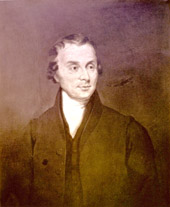Luke Howard
| Luke Howard | |
|---|---|
 |
|
| Born | 28 November 1772 London, England |
| Died |
(aged 91) London, England |
| Residence | England |
| Citizenship | United Kingdom |
| Nationality | British |
| Fields | Meteorology, Chemistry, Pharmaceuticals |
| Known for | Naming the clouds |
Luke Howard, FRS (28 November 1772 – 21 March 1864) was a British manufacturing chemist and an amateur meteorologist with broad interests in science. His lasting contribution to science is a nomenclature system for clouds, which he proposed in an 1802 presentation to the Askesian Society.
He was born in London, the son of Robert Howard, a lamp manufacturer, and educated at the Quaker school in Burford, Oxfordshire. He was a Quaker, later converting to the Plymouth Brethren, and became a pharmacist by profession. After serving an apprenticeship with a pharmacist in Stockport, Cheshire he set up his own pharmacy in Fleet Street in 1793. In approximately the year 1797 he then went into partnership with William Allen to form the pharmaceutical company of Allen and Howard in London. A factory was opened on the marshes at Plaistow, to the east of London. The partnership was dissolved in 1807 and the company eventually (1856) became Howards and Sons.
He was elected a Fellow of the Royal Society in 1821. He spent the years 1824 to 1852 in Ackworth, Yorkshire.
He died in Tottenham, London. He had married Mariabella Eliott (1769–1852); they had several children including John Eliot Howard, FRS, chemist and botanist.
Luke Howard has been called "the father of meteorology" because of his comprehensive recordings of weather in the London area from 1801 to 1841 and his writings, which transformed the science of meteorology. Howard had an earlier interest in botany, presenting a paper 'Account of a Microscopical Investigation of several Species of Pollen, ...' that was published in the Linnean Society's Transactions for 1802, but wrote to Goethe that his passion was for meteorology. In his late twenties, he wrote the Essay on the Modification of Clouds, which was published in 1803. He named the three principal categories of clouds – cumulus, stratus, and cirrus, as well as a series of intermediate and compound modifications, such as cirrostratus and cirrocumulus, in order to accommodate the transitions occurring between the forms. He identified the importance of clouds in meteorology:
...
Wikipedia
